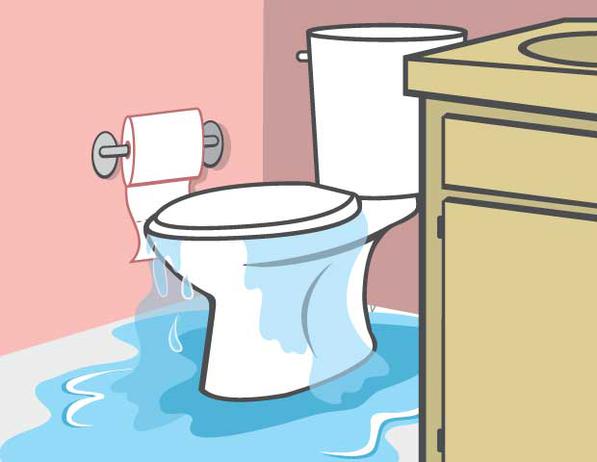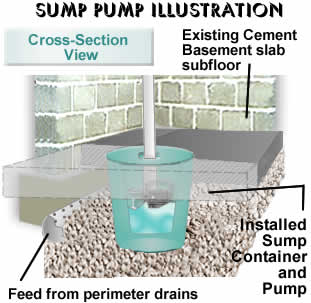 While most problems occur during heavy rainfalls or spring thaws, many basements flood because the house is positioned too low on a sloping site, or cracks have developed in the foundation, or there is an improperly installed drainage system. Â If you know your basement is prone to flooding, we suggest hiring a waterproofing expert to identify and remedy the causes. Â You should also install a sump pump system that will remove ground water before it can seep through your basement floor and walls and damage appliances, furniture, walls and flooring.
While most problems occur during heavy rainfalls or spring thaws, many basements flood because the house is positioned too low on a sloping site, or cracks have developed in the foundation, or there is an improperly installed drainage system. Â If you know your basement is prone to flooding, we suggest hiring a waterproofing expert to identify and remedy the causes. Â You should also install a sump pump system that will remove ground water before it can seep through your basement floor and walls and damage appliances, furniture, walls and flooring.
What is a Sump Pump?
A sump pump is a small pump installed in the lowest part of a basement or crawlspace. Its job is to help keep the area under the building dry and to prevent it from floodÂing. Sump pumps are installed in specially constructed sump pits. Water enters the sump pit through drains or by natural water migration through the soil. The sump pump’s job is to pump the water out of the pit and away from the building so the basement or crawlspace stays dry.
 Types of Sump Pumps
Types of Sump Pumps
“Primary†sump pumps are the standard kind of pumps used in most residences. They are designed to pump seepage water out of your basement and prevent floods. Primary sump pumps can pump up to several thousand gallons an hour.  There are two types of primary sump pumps:
Pedestal Sump Pump — The motor on this type of pump is mounted on a shaft and positioned above your sump basin. Pedestal sump pumps are good for small basins (10†or less), as the pump base is submerged but the pump motor is not.
Submersible Sump Pump – This type of pump has a sealed motor. The entire unit sits under the water in the sump basin. Because the motor is placed under the water, you will need a bigger pit. As long as there is enough room, submersible sump pumps are recommended for home installations because they are quieter and less obtrusive looking. They are also safer if there are children or pets in the house because the basin can be covered with a lid.
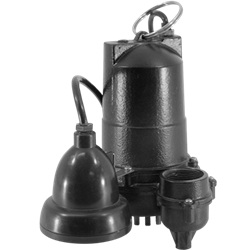 Choosing the Right Size Pump
Choosing the Right Size Pump
Sump pumps range in horsepower and the pumping capacity varies accordingly. Generally speaking, the higher the horsepower, the more gallons per hour it will pump. ABS Robusta sump pumps, for instance, come in ¼ HP, ⅓ HP and ½ HP.
Average Homes — A ½ HP or â…“ HP sump pump is adequate for most homes. A â…“ HP sump pump, like the high performance Ion StormPro WC33i by Metropolitan Industries, can pump 44 gallons of wastewater per minute at 10’ levels.
Homes Susceptible to Flooding  — If you live in an area with a high water table, flood plain or low lying area that is very susceptible to flooding, or if you have an installation with a high vertical lift (20 to 30 feet) and/or long horizontal run (150 to 250 feet), you may need a stronger ¾ HP pump like the Ion StormPro BA75i by Metropolitan Industries that provides 20 to 25% more pumping capacity over a ½ HP sump pump, or around 75 gallons per minute.
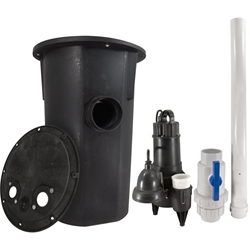 DIY Installation is Quick and Easy
DIY Installation is Quick and Easy
Installing a sump pump in your basement can be a DIY project if you are handy and have the right tools. There are even do-it-yourself sump kits that can be installed in about 30 to 60 minutes and include everything you need to complete the job.  Here are step-by-step directions on how to do it and the equipment you’ll need.
If you aren’t up for the task or if the construction or configuration of your basement makes installation a challenge, we suggest that you hire a plumber with sump pump experience or a basement waterproofing company. A contractor who specializes in pump installations is another option.
Arm Your Sump Pump with an Alarm
If there’s a power outage or a mechanical failure, your sump pump won’t pump and your basement will be at risk of flooding. That’s why it’s a good idea to include a sump pump alarm in your system. A sump pump alarm will warn you that sump pump is not functioning and the water level in the sump pit is rising, allowing you time to intervene before your basement floods.
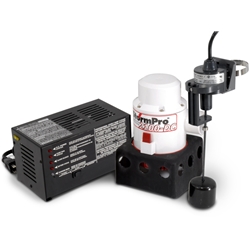 You can choose a “local†sump pump alarm that will sound a very loud audible alert, such as the Floodfree, or a “remote monitoring†sump pump alarm that will notify you by phone, email or text message, like the PumpAlarm Cellular Water Alarm communicates via a cellular connection.
You can choose a “local†sump pump alarm that will sound a very loud audible alert, such as the Floodfree, or a “remote monitoring†sump pump alarm that will notify you by phone, email or text message, like the PumpAlarm Cellular Water Alarm communicates via a cellular connection.
In addition to equipping your sump pump with a sump pump alarm, it’s a good idea to add a battery-powered backup system so your sump pump will continue to pump water even if the power goes out.
Contact us for Expert Advice
If you are unsure what size sump pump to get for your basement or have questions about a DIY installation, contact the technical advisors at diycontols.com for assistance.


